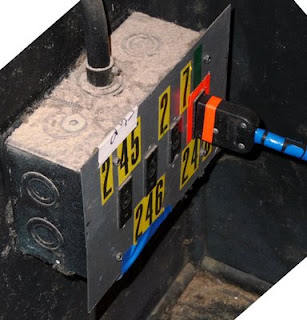"In the dark the innocent can't see." -
Melissa Etheridge. Theatre Safety for the very young starts with hazard recognition. The younger the student, the less aware they are of potential dangers around them. One of the first dangers a child learns is thermal. Start there with stage lights.
You can expand your Fire & Emergency Training to have fire exit drills in the middle of show rehearsals. Start out easy and get them to understand that getting out of the building is a priority, then later you can 'complicate' their decision making by making them find and take a different route by declaring the 'obvious' or 'regular' route as "not available." People tend to exit buildings the same way they came in. You have to challenge them to find and know alternate routes should their typical or normal one be blocked.
Respect for property and others is also an important safety item. Students that 'tear things up' and harass others can be a danger to themselves and others. They are frequently the ones that don't listen to instructions, distract others so they can't listen, and go climbing or pulling on things that may fall down. These students go on to disrespect property and can damage important safety systems.
.JPG) Don't just say "NO!"
Don't just say "NO!" Explaining to the students why and how signs, ladder guards, PPE, and other safety equipment is there to protect them helps them understand why damaging that equipment may injure themselves or others. Actions have consequences. So do inactions.
Curiosity killed the cat. Although most elementary schools don't have counterweight rigging systems, it is still a good idea to familiarize the students with what they are and how they work. They have to know what the equipment is and see the potential danger so if they are visiting another venue that has that type of equipment, they don't reach-over and release a rope lock 'just to see what it does.'
From there you can start working on tool safety. Most kids never get any real instruction on basic tools like hammers, screwdrivers, pliers, and wrenches.
If they can use it, they can misuse it. First-up is keeping the work space clear of nails, tacks, screws, splinters, and trip hazards. From there, go through basic tools like hammers (here is a good chance to show them why they should
always be wearing safety glasses around
anyone stapling or nailing. Show them how far a nail or staple can go when it ricochets - that's always an eye opener (not to be puny). Kids like "gross" - get a cow eye from the biology teacher and poke a nail through it -
eewe!Painting can also be hazardous. Help the students understand the difference between oil-based paints, latex-based paints, and water based stage paint (Green-ness, chemical hazards, clean-up hassles, skin damage, fire retardancy, etc.). Get them to wear gloves to protect their hands, safety glasses to keep the paint splatter out of their eyes, aprons to protect their clothes, knee pads if they are working on the floor (to protect them from jamming-up their knee-caps with a nail or screw someone left behind).
1000 ways to die. For each tool there is a correct way to use it, and
a thousand ways to misuse it.
Tunnel vision. Show them what can happen when you don't see past your work-surface (what is behind the board, under the flat, around the corner) or surroundings.
As you approach each task of building a set, or moving it, or striking it; challenge them to think about safety. Is there a safer way to do this?
More people,
better tools,
different PPE...
And of course, keep a record of each student's training and skills. If they injure themselves or others later, it can help to know what they were permited to do verses what they took upon themselves to do.
 If the fixed conduit or flex conduit body is the only ground path you have, then the ground is broked (open circuit) if the conduit becomes separated.
If the fixed conduit or flex conduit body is the only ground path you have, then the ground is broked (open circuit) if the conduit becomes separated.


.JPG)
.JPG)



.JPG)










